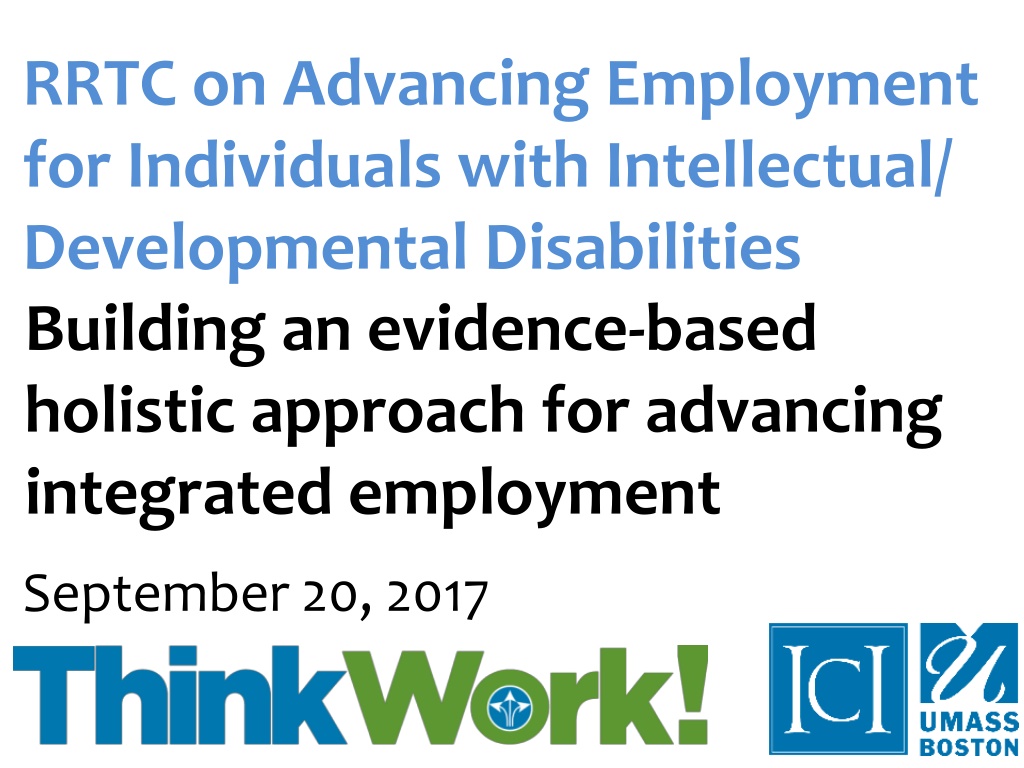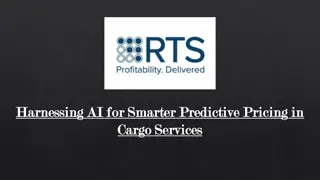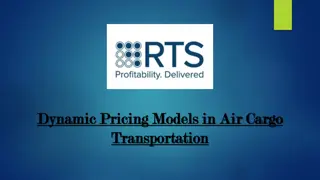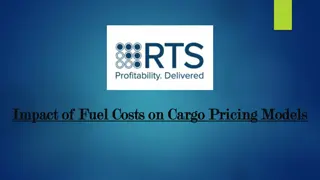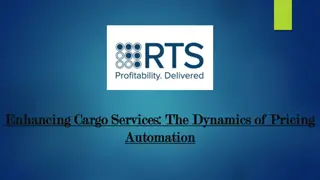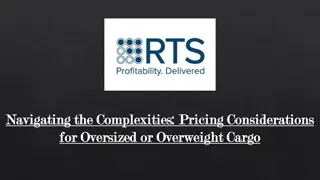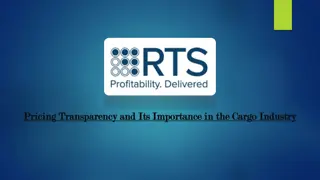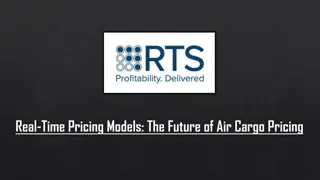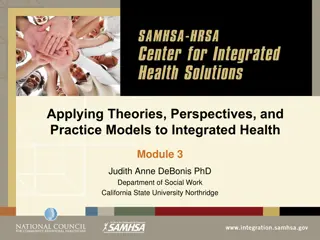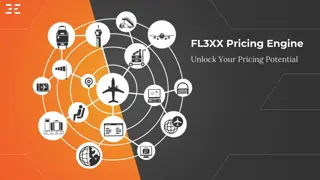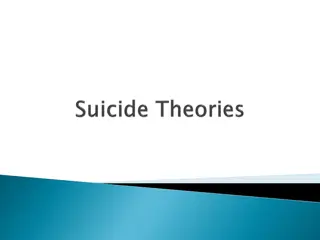Two Alternative Theories of Pricing Behavior
The Kinked Demand Curve Theory and Price Leadership theory are two alternative pricing behavior theories in oligopolistic markets. The Kinked Demand Curve Theory suggests that firms respond aggressively to price cuts but ignore price increases, while Price Leadership involves a dominant firm setting prices for smaller firms to follow, facilitating tacit collusion in industries like airlines.
Download Presentation

Please find below an Image/Link to download the presentation.
The content on the website is provided AS IS for your information and personal use only. It may not be sold, licensed, or shared on other websites without obtaining consent from the author.If you encounter any issues during the download, it is possible that the publisher has removed the file from their server.
You are allowed to download the files provided on this website for personal or commercial use, subject to the condition that they are used lawfully. All files are the property of their respective owners.
The content on the website is provided AS IS for your information and personal use only. It may not be sold, licensed, or shared on other websites without obtaining consent from the author.
E N D
Presentation Transcript
RRTC on Advancing Employment for Individuals with Intellectual/ Developmental Disabilities Building an evidence-based holistic approach for advancing integrated employment September 20, 2017
Acknowledgements The work of this Center was developed under a grant from the National Institute on Disability, Independent Living, and Rehabilitation Research (NIDILRR grant#90RT5028) . NIDILRR is a Center within the Administration for Community Living (ACL), Department of Health and Human Services (HHS). The contents of this presentation do not necessarily represent the policy of NIDILRR, ACL, HHS, and you should not assume endorsement by the Federal Government. 2
Memorable Quote Employment is a way for people with disabilities to give to the community and see what they have to offer. We re givers, not just takers. (Max Barrows, SABE)
Setting the stage Individuals want to work. Well-established technology exists for employment support. State and federal policy emphasize work as a priority for public supports. Only 14% of individuals served by state IDD agencies work in individual integrated jobs.* *National Core Indicators, 2015-2016 5
Number in Employment and Day Services Source: ICI National Survey of State IDD Agency Day and Employment Services
Examples of stakeholder engagement Dissemination partners Project advisors Member checking Bi-monthly 44 webinar series (400+/webinar) Social media presence State of the Science process Sponsored presentation/feedback sessions IdeaScale Invited meeting 8
Strand 1: Individual and family engagement Goal Develop and test an information, outreach, and support framework for individuals and families. 9
What we know from past research Young adults expect to work as adults. Working-age adults want to work. Families are influential in the decision-making process, and parent expectation is a strong predictor for employment. Families lack knowledge. School-based staff, employment consultants, and provider culture influence employment decisions. 10
Research questions What strategies have been successful in engaging families in employment? What information and support approaches are useful/effective for families? How can we share information in a way that is most useful for families? 11
Method Scoping literature review In-person and online forums and focus groups Family engagement intervention (in process) 12
Findings: Scoping literature review Themes Family modeling shapes employment experiences. Engaging families supports a focus on employment. Family/individual demographics are related to employment. 13
Findings: Scoping literature review Strategies Training Explore, Prepare, Act FEAT Planning tools The Arc s Build Your Plan LifeCourse tools Online resources Let s Get to Work (WI) Peer-to-peer outreach Social media
Findings: Online focus groups and forums Confusing guidance and low systems expectations. Navigation is hard: lack of alignments & discontinuity. System lacks capacity. More success when relying on self and family.
Intervention (ongoing) Goal is 100 families (young adults ages 14-24). Engagement strategy based on findings from literature review, forums, and focus groups. 4-pronged approach: Arc Center for Future Planning Tool Private Facebook group (discussion, reminders) Positive messages about employment Information and referral 16
Strand 2: Employment support practices Goal Assess a cost-effective strategy for improving the implementation of employment support practices. This will be done through integration of online training, data-based performance feedback, and facilitated peer supports.
What we know from past research Extensive literature on effective support practices. 35,000 employment consultants nationally (estimated). Limited implementation of best practices. Training + mentoring improved number of placements, wages, time to placement.
Research questions What strategies do effective employment consultants use? How do consultants make decisions about which support strategies to use for each individual? What is the effectiveness of data-based feedback, online training, and a community of practice? 19
Methods Qualitative interviews with employment consultants, supervisors, families, and individuals Employment consultant intervention (in process) 20
Findings: Interviews Build trust with the job seeker and family. Find out what the job seeker wants out of life, and seek employment that fits their vision. Make decisions about support strategies based on individual preferences and support needs. Be creative in the search. Look for tasks and opportunities, not just job openings. Network with employers & community businesses. Involve the job seeker in every step of the process.
Intervention: Employment supports (ongoing) 167 participants, 85 CRPs, 30 states Baseline and quarterly surveys Intervention components Daily activity survey by smartphone Monthly community of practice & goal Monthly performance feedback College of Employment Services (15 lessons) Mentoring 23
Preliminary findings: Employment consultant time distribution
Strand 3: Community Rehabilitation Providers (CRPs) Goal Develop a strategy for supporting CRPs to rebalance resources to emphasize individual integrated employment.
What we know from past research Only 9% CRP staff dedicated to employment. 89% CRPs said facility-based programs needed. Direct support staff experience confusion about roles; feel unprepared. Organizational transformation requires alignment of goals, communication, resources, rapid job placement, community partnerships, wrap-around supports. Change driven internally, not by state goals and policy. 27
Research questions What are the characteristics of CRPs that have transformed services to emphasize high-quality integrated employment? What organizational, state, and community factors influence organizational transformation? What is the impact of a facilitated peer network of providers on rebalancing of resources and employment outcomes? 28
Methods Delphi panel of experts to confirm and augment a framework for organizational change as identified through past research. Case studies of CRPs that have undergone successful organizational transformation. Provider intervention (in process) that tests a strategy that includes use of the Agency Change Toolkit.
Findings: Delphi panel Organizational factors ranked by perceived importance 1. Clear and consistent goals 2. Agency culture that values inclusion* 3. Active, person-centered job placement process (one person at a time) 4. Strong internal & external communications 5. Reallocated and restructured resources *New element
Findings: Delphi panel (continued) 6. Ongoing investment in staff learning* 7. Focus on customer engagement/feedback* 8. Effective performance measurement, quality assurance, & program oversight* 9. Holistic approach to supports 10.Multiple & diverse community partnerships *New element 31
Findings: Case studies Arc of Westchester (NYC metro) At Work (Seattle metro) Work, Inc (Boston metro and Cape Cod) Penn-Mar Human Services (rural Pennsylvania) The Delphi Panel findings confirmed and refined the structure, while the case studies provided on-the-ground examples, strategies, and depth to the 10 organizational factors. 32
Organizational Transformation
Intervention (ongoing) 12 Arc chapters over two years, selected through RFP process Intervention components Agency Change Toolkit Guided self-assessment Customized organizational action plan Monthly expert technical assistance Monthly topical webinars Leadership summit in Washington, DC 34
Agency Change Toolkit Online tool organized by 10 elements for organizational transformation. Guided by Delphi panel and case study research results. Provides self-assessment, promising practices, concrete tools, and templates for organizations at multiple stages of transformation process. Being piloted with Arc providers. 35
Strand 4: Aligning policy and practice across state agencies Goal Analyze state employment systems policies and practices and their relationship to individual outcomes at a multi-agency level. Define policies and practices of high-performing state employment systems.
What we know from past research State IDD agency outcomes vary widely & agencies have inconsistent/competing priorities. Non-work services are growing. In 2015-2016, only 14% of individuals served by state IDD agencies worked in individual integrated jobs. In FY2015, only 13% of state IDD funding for day services was spent on integrated employment. Interagency coordination of services is challenging. 37
What we know from past research Higher-Performing States Model Hall et al., 2007
Research questions What are the characteristics of higher- performing employment systems? What is the relationship between systems characteristics and employment outcomes?
Methods Secondary data analysis to determine higher performing state systems Composite indicator (IDD, VR, Education) Case studies of higher-performing state systems Topical state policy analyses that describe challenges and strategies Prevocational services Support coordination/case management The employment process & braiding services
Findings: Composite indicator rankings Overall CI Score 47.38 47.26 46.88 44.77 44.26 42.48 41.98 40.51 39.78 39.60 IDD Score 21.60 22.76 22.76 21.60 22.84 15.42 21.67 14.33 14.47 19.20 VR Score 15.22 9.63 13.75 12.81 10.87 13.78 12.79 14.72 13.92 14.32 Education Score 10.56 14.86 10.37 10.35 10.56 13.28 7.52 11.46 11.39 6.08 Rank 1 2 3 4 5 6 7 8 9 10 MD NH VT OR WA IA OK SD CO DE
Findings: Case study research in MD Success over the long term depends on a cadre of stakeholders. Leadership is most effective when distributed across multiple levels of responsibility. Consistent allocation of funds for long-term services for youth exiting schools is critical. Cements expectation for collaboration between school and adult service systems. 42
Findings: State-level policy analyses Leadership through setting values, setting direction, and creating the infrastructure for change. Support coordination/case management to increase prioritization of employment. Managing the employment process, including sequencing funding with VR (in process). 43
www.ThinkWork.org/rrtc john.butterworth@umb.edu cindy.thomas@umb.edu
